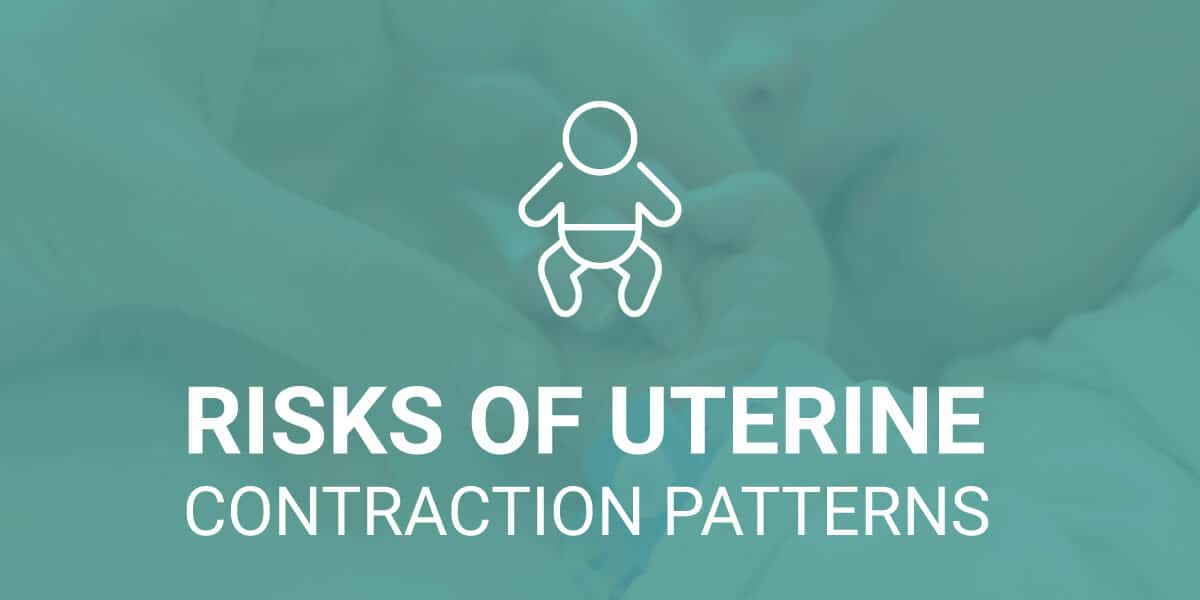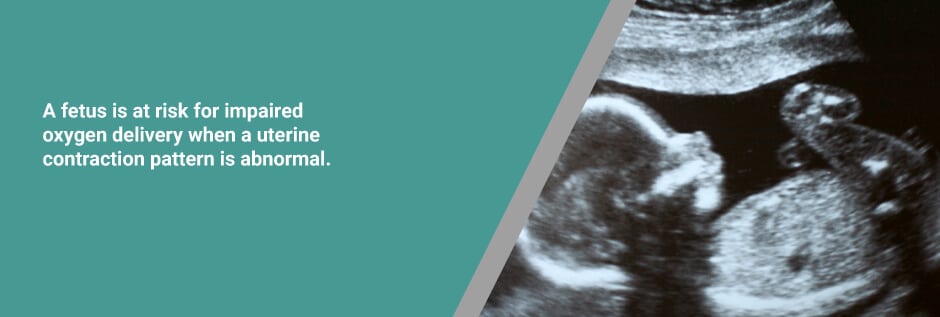
Main Takeaways:
- Uterine contractions can compress the blood vessels in the uterus, potentially interfering in the transfer of oxygen to the placenta and the baby.
- In a normal labor, one contraction every two to three minutes or less than five contractions in a 10 minute period is ideal.
- A uterus must rest between contractions, having sufficient uterine resting tone (soft to the touch), and uterine resting time (about one minute).
The fetus relies on an adequate circulation of blood in the uterus and umbilical cord to provide enough oxygen to maintain fetal well-being during labor. The condition of the fetus is assessed during labor by monitoring the fetal heart rate.
There are characteristic patterns of the fetal heart rate reflected on a tracing that indicates good oxygenation. The fetus is at risk for impaired oxygen delivery where the uterine contraction pattern is abnormal.
Why Uterine Contraction Patterns Are Important
An abnormal uterine contraction pattern accompanied by non-reassuring fetal heart rate patterns are a concern. Steps must be taken by nurses, midwives and doctors to avoid this occurrence.
There are many articles in the medical literature about the interpretation of fetal heart rate patterns in assessing fetal well-being, but much of the literature fails to address or adequately consider the uterine contraction pattern as a critically important variable in the evaluation of fetal well-being.
There are a number of characteristics of the uterine contraction pattern that may contribute to stress on the fetus during labor, thereby increasing the risk of harm for the baby. Uterine contractions can compress the blood vessels in the uterus, potentially interfering in the transfer of oxygen to the placenta and the baby.
Contractions can also compress the umbilical cord, which may affect the flow of oxygenated blood to the baby. Both events occur in most labors, without consequences for the baby. But where these events occur too frequently or too severely, the risk of injury increases.
Consequences of Poor Oxygenated Blood Flow
There are a number of characteristics that demonstrate excessive uterine activity and must be avoided if an injury to the fetus is to be prevented. An excessive uterine activity can lead to impaired oxygenation of the fetus. While the fetus has a remarkable ability to tolerate periods of impaired oxygenation, that tolerance has limits.
Eventually, if excessive uterine activity persists, the fetus can develop a condition called metabolic acidosis and, if severe enough, brain injury and even death can occur. There are a number of contraction patterns that can contribute to the risk of injury or death to the fetus.
How Often Should You Be Having Contractions?
Contraction frequency is an important issue. The frequency of uterine contractions must be sufficient enough to dilate the mother’s cervix and promote the descent of the fetus down the birth canal.
Generally speaking, the desired frequency of uterine contractions in a normal labor is one contraction every two to three minutes or less than five contractions in a 10 minute period.
Where contractions occur more frequently, there is a risk that the fetus will not tolerate the added stress if this pattern is sustained. Overly frequent uterine contractions is called “tachysystole.”
What is Oxytocin and Why is it Used in Labors?
In some labors, a drug is used to assist with the uterine activity. The drug is called “oxytocin” or “syntocinon.” The effect of this drug, administered to the mother, is to increase the frequency, duration, and intensity of uterine contractions to promote delivery.
One risk associated with oxytocin is the possibility of excessive uterine activity. When oxytocin is used, should overly frequent contractions occur (more often than one contraction every two minutes), the oxytocin must either be turned down or stopped.
The abnormal uterine contraction pattern must be observed to see if it resolves. If stopping the oxytocin does not fix the problem, delivery may be necessary at that point, particularly if the fetal heart rate pattern is non-reassuring.
Why the Length of Contractions is Important
The duration or length of contractions is another important feature. In a normal labor, the desired length of contractions is between 45 and 60 seconds. Contractions that last longer than 60 seconds, if persistent, may indicate that the uterus is contracted for excessive periods of time, contributing to fetal stress.
A contraction that lasts longer than 90 seconds is called a “tetanic” contraction. Again, contractions lasting too long are abnormal and result in added stress on the fetus and must be avoided.
Make Sure the Uterus Gets to Rest
It is important for fetal well-being that the uterus rest between contractions. There are two important components to this rest: uterine resting tone, and uterine resting time. During contractions the uterus, which is a muscle, tenses to provide the force needed to advance the labor.
What Is the Uterine Resting Tone?
The uterus is taut during contractions or said to have increased “tone.” Rest between contractions requires the uterus to be “soft” when touched or palpated, having a decreased tone. If the uterus is not soft then the tone is increased. The muscle may not be sufficiently relaxed to promote good circulation of blood.
This could result in decreased blood flow between contractions, which is a concern for fetal oxygenation. It is important for the nurse to touch the mother’s belly between contractions to ensure that the uterus is soft.
If there is a persistent increased tone between contractions, the cause for this problem must be identified and a plan to manage the problem established, which may involve decreased oxytocin or expedited delivery.
How Long is the Uterine Resting Time?
There must also be sufficient time between contractions to allow the fetus to “recover” from the stress of the previous contraction. Ideally, the resting time between contractions should be one minute. Short resting times can contribute to unnecessary fetal stress.
Other Contraction Patterns
Contractions that occur in quick succession may also be problematic. Where two contractions occur very quickly with little rest in between it is called “coupling.” Three contractions in quick succession is called “tripling.” These patterns are abnormal and must be avoided.
An abnormal uterine activity should always be seen as concerning, whether the patterns are seen with or without non-reassuring fetal heart rate patterns. If excessive uterine activity occurs with a non-reassuring fetal heart rate pattern, it is that much more worrisome and must be addressed clinically.
Doctors and nurses must be sensitive to the possibility of building fetal metabolic acidosis when these conditions occur together and are required to take action.
Contact a Trusted Birth Injury Lawyer Today
A common feature in many of the cases that BILA lawyers handle for families of children born with cerebral palsy or other traumatic birth injuries is the presence of abnormal uterine activity, often associated with the injudicious use of oxytocin.
In many of these cases, the injury suffered by the newborn would have been avoided entirely with the proper recognition of these patterns and the appropriate clinical response. Contact one of our trusted lawyers today.

Toronto birth injury lawyer Charles Gluckstein was appointed President of the Ontario Trial Lawyers’ Association from 2013-2014. Since 2014, Best Lawyers® International has consistently recognized him as a leader in the personal injury field. In 2014 he was awarded the LEXPERT Zenith Award for Leading Personal Injury Lawyer in Practice Excellence, in recognition of thought leadership and the setting of new standards for the Personal Injury Bar. In its annual publication, the Canadian Legal LEXPERT® Directory has listed Charles as being repeatedly recommended by his peers in the area of personal injury for the Toronto region.






